Week 6 – Darwin, Mary River, Kakadu
Tuesday 5th
OK decision made, we are out of Darwin today. A couple of errands first, eg sending back to Brisbane 22KG of items including clothes. Bus Freight was the solution! The next task was on to the shopping centre to stock up on food. Finally we were able to leave the city at noon. It would have been so easy to have stayed another day!
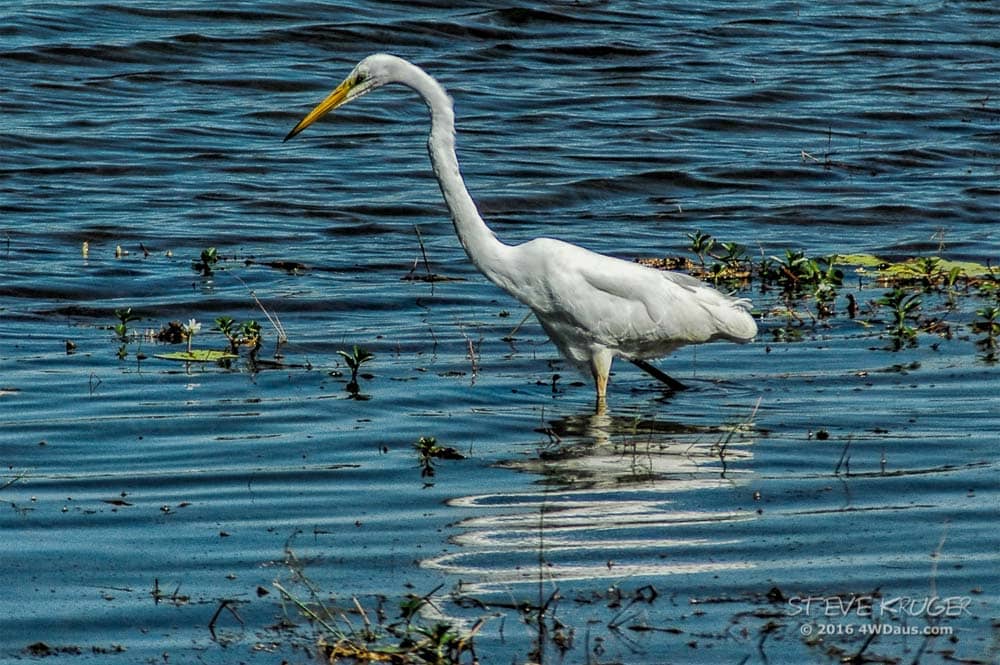
Great White Egret, Kakadu, NT
The first stop was the Humpty Doo Hotel where they claim to have the widest pair of buffalo horns you have ever seen. We believe these horns are close to 8 foot from tip to tip. Now that’s a lot of bull, OK buffalo! Whilst visiting the hotel, Steve used the opportunity to add to his T shirt and beer stubby holder collection.
Next stop was Fogg Dam. An interesting place where the Australian government post WWII attempted to grow rice in the harsh country side. The attempt was a failure due to the magpie geese finding the rice easy pickings, but the resulting dam, even though it’s very shallow, is teaming with wild life, including many varieties of birds… over 180 species. This is also the area that has the most densely populated bio mass of rats (8 tonnes / sq km) and pythons (800kg / sq km) in Australia. It is not far from the Mary River which is said to have the densest population of crocs in Australia.
Sadly the wildlife has become so used to people here and this is where we believe the animals can be at their most dangerous. We have encountered many croc warning signs on our travels and to a certain degree we have become desensitised by them. Today we found a freshwater croc that was a little too friendly for our likings. It reminds us very much of the problems rangers face with dingos on Fraser Island, especially with children. It is very rare for freshwater crocs to be aggressive, so we reported the croc to rangers who were going to look into relocating it to a quieter location. The ranger also showed us a copy of the local newspaper from last week where a 4WD and trailer ran over a 3m salt water croc on the Arnhem Land highway near the Window on the Wetland centre (60kms south of Darwin). Even the collision with a 4WD didn’t kill this one. A remarkable creature which certainly gets our respect.

Kakadu Lagoon
Tonight we are back to bush camping on the Adelaide River, certainly a welcome break to the caravan park in Darwin, although the flushing toilets and hot showers are certainly being missed.
Cane toads, although these pests have only just reached the out skirts of Darwin, they have been with us on our whole trip from Brisbane to Kakadu. They are marching across the top end and will not stop until they reach the West Coast. We are certainly glad we are going to be seeing the balance of our trip before they conquer the roads ahead of us and change the areas forever.
Wednesday 6th
We both had a good night’s sleep last night except we can feel the humidity is rising slowly each day. It was great not hearing the sounds of caravans and people again. Although, we must admit it is good being around people at times, listening to their stories and experiences. We spent some time with Maur and Merv (from Bunbury WA) in Darwin and learnt of their experiences in life and what retirement has bought to them. This class of retiree / adventurer is really getting more from life.
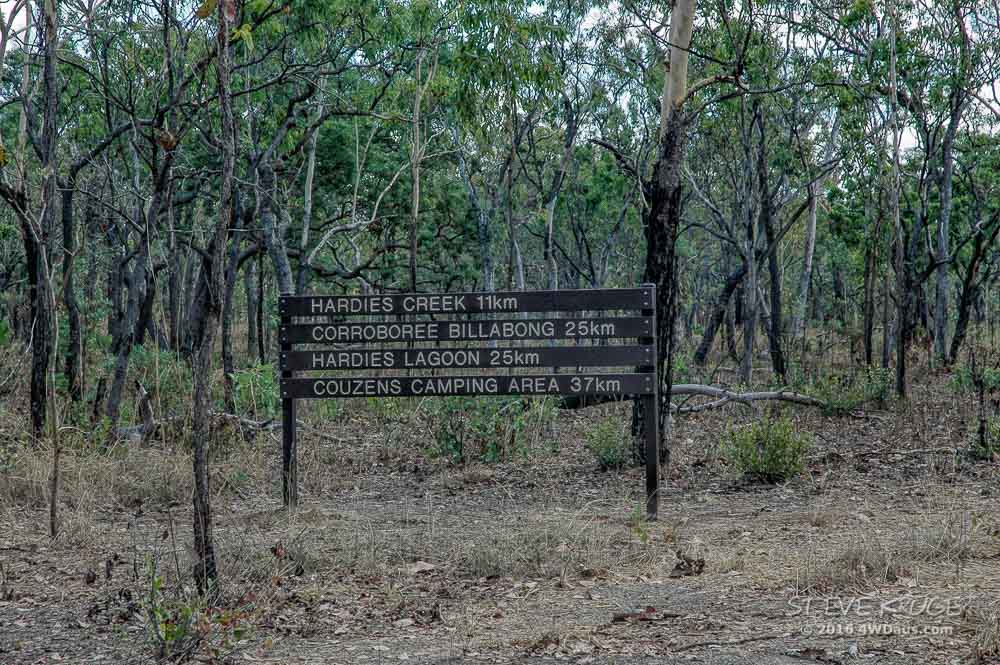
The Road to Corroboree Billabong, Mary River NP, NT
This morning we have headed back to Batchelor via the Marrakai Track and from there we will return to our Kakadu experience. We entered the Mary River National Park about noon and headed off on one of its 4WD tracks. Being the end of the dry season, most roads / tracks are open. You can see where visitors earlier in the season ran into very soft ground with some managing to bog their vehicle and others simply tearing up the track. By the end of the wet season the water will reclaim the ground once again, with some parts being many metres under water. The mind simply boggles at the sheer quantity of water in this area during the wet.

Mary River National Park
First stop in the Mary River National Park was Bird Lagoon; the lagoon was dry and guess what; yep no birds! Not deterred by this we continued deeper into the park. Hardies Creek made up for everything, much bird life, kangaroos and even a dingo. It was simply amazing to be able to walk up (although quietly) to the large flocks of birds sitting on the water’s edge. From here on we could only traverse the track at a slow pace due to washouts, bulldust and corrugations. From Hardies Creek we next travelled to Hardies Lagoon. This meant crossing the Hardy Creek which was the first water crossing we have done for days. There were people there fishing and generally taking in the beauty of the rapids. Would have been a wonderful place to swim and wash away the dust except ever present threat of crocs.
It was only a short drive to Corroboree Billabong. Again this was a impressive water feature which had purple lilies instead of the white we usually encountered. As Couzens Lagoon was a camping area we headed there next. The camping area is nestled along the side of a branch of the Mary River. The wild life is prolific here and the croc population is also well represented. From the lookout with our binoculars, we could make out the profiles of 2 crocs in the water, but you have to look carefully as they blend in so well. If you look carefully in the foreground of this sunset picture there is a croc’s head just visible near some submerged branches. We named this scene “Beauty and the Beast”.
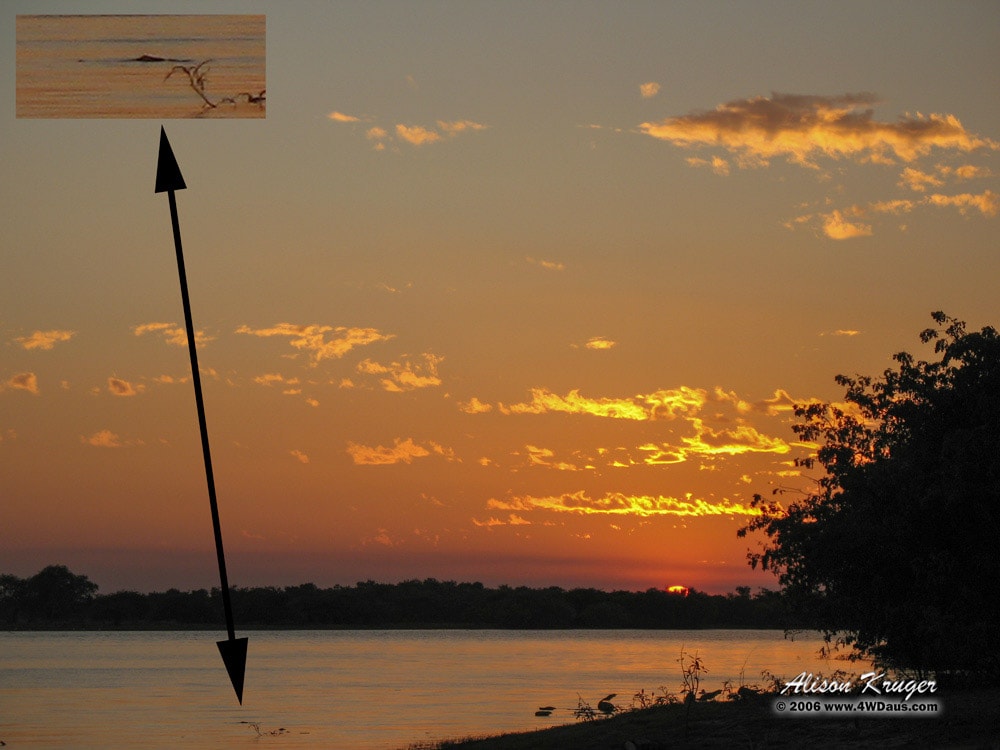
Corroboree Billabong Croc in the Sunset
Needless to say we camped a long way from the water’s edge.
Thursday 7th
The drive this morning along the Wildman track was very pleasant and took us through some beautiful countryside. Again it was a 4WD track which seems to have been used very little over the preceding dry season and consequently was not badly deteriorated like the previous days track.
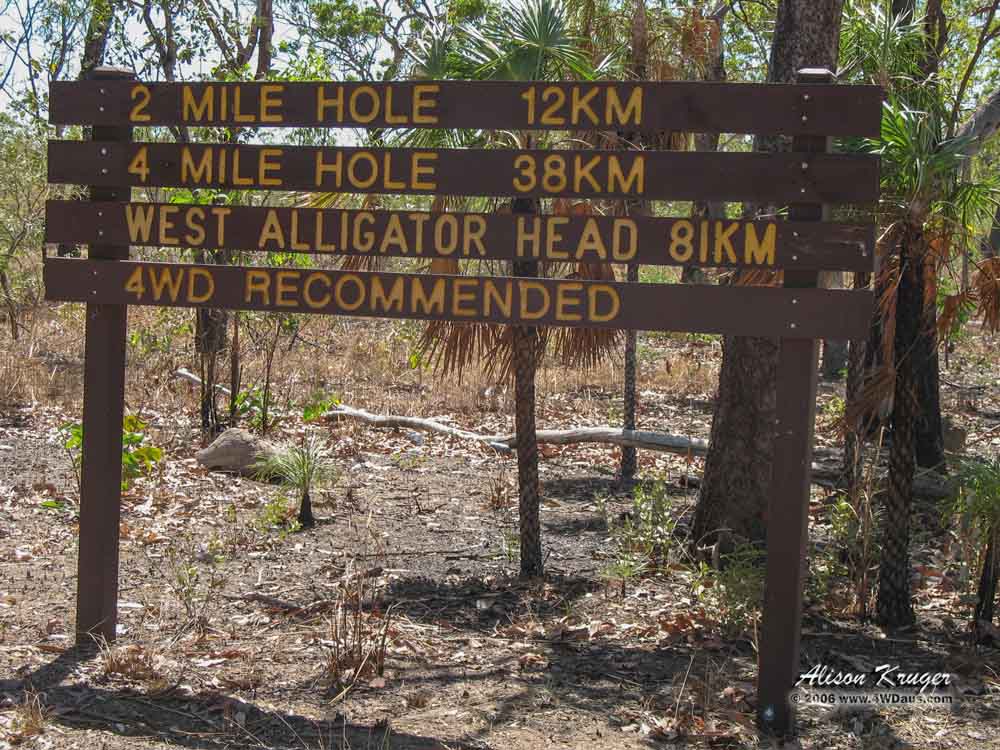
West Alligator Head Signpost
We went to recharge a camera battery today and discovered our battery inverter had failed. This inverter is very important to our photography, laptop and camp lighting so we decided to head back to Jaycar in Darwin whilst the trip was only 140km each way to have it replaced under warranty) – the next Jaycar shop would be Perth. This would also give us the opportunity to replenish water, establish a new web site (we have outgrown the current site due to the size limitations associated with the TPG site) and also to get a couple of vehicle spares.
As it was Thursday night, we also decided that the Minidil Markets would be fun to do again. We ate an interesting mix of cuisine, finished off with an awesome fruit smoothie and waffle, and watched the sun go down. A pleasurable evening! On arriving back at the caravan park we caught up with Maur and Merv… it was excellent meeting old friends again, even if it had been less than a week since leaving.
Friday 8th
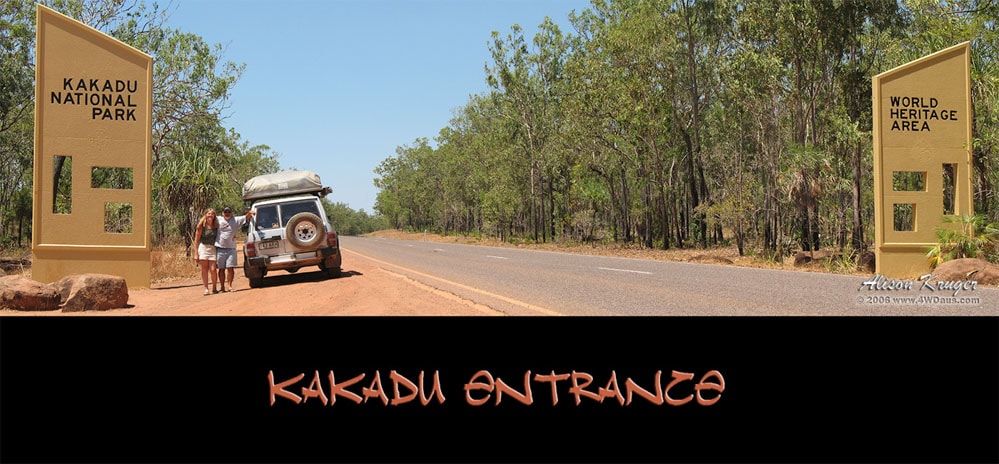
Kakadu Entrance 2006
Today we finally made Kakadu National Park!! It seems like there is some magical force trying to prevent us getting here. After some discussion we decided that the first place we would head for was West Alligator Head, a short 81km drive over generally good track. The drive was truly different from the other drives we had through the park, very little wildlife, but coastal dunes, very large river flats and many groves of palms. We believe that the track has only been open for about a week this year, on account of the large river flats you must cross to get here, and the later than usual finish to the Wet. On the way in we suffered our first flat tyre for the trip. Now which tyre was it??? Well as Murphy’s Law has it – it was the one we had replaced in Darwin. We carry a air pump which operates the diff lockers, this also doubles as a tyre inflator. We quickly had the tyre inflated again and then listened for the leak. Some good planning also meant we carry a tyre plug system. Within a relatively short period of time the tyre was plugged, reinflated and back on the vehicle. Unfortunately, while we had the tyre off, we noticed that the exhaust bracket had snapped and even worse the rear axle has cracked in the triangle weld. So it appears the Kakadu curse is back. We know the axle crack (from experience) is a common problem due to a faulty batch of axels Nissan produced.
We headed onto West Alligator Head and then to Pococks Beach. This is the first time we have seen the Northern Territory Water outside Darwin. The campsite has a turtle nesting area on one side and a beach approximately 3kms long. We also had some company with Rod, Bren and Ben, some locals from Darwin who love their fishing.
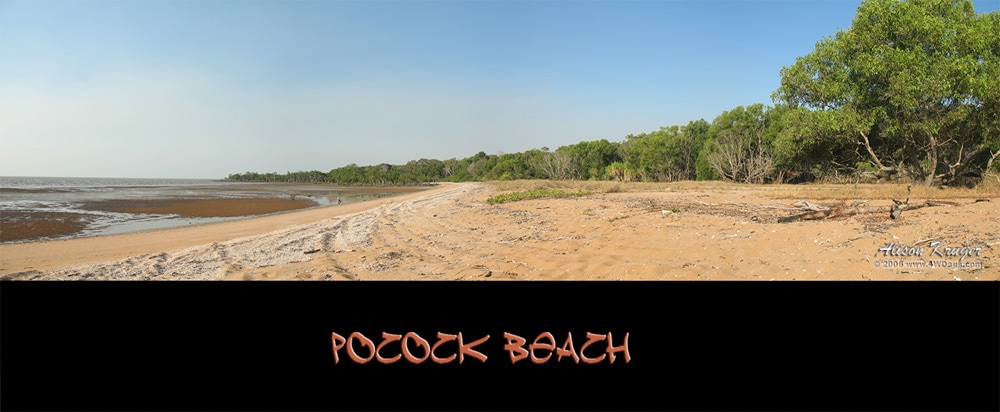
Pocock Beach
After dinner we sat down to rehydrate ourselves from the day and hear some more stories about fishing, boating and crocs. A very enjoyable evening spent in the cool of the sea breezes and the warmth of the camp fire. About 7.30pm the moon started rising and was full, orange and big. WOW.
OK here’s an interesting one, it appears we camped in Hermit Crab central. As we walk around our tent the ground is alive with small crabs and their assortment of shells scavenged from the beach. There seems to be this super highway between the bush and the water’s edge. Later in the evening, we ventured down the beach to try and locate a turtle laying eggs. It appears we left our run a little too late as the tracks lead up and back. We also came across pig tracks that would have been looking for ghost crabs to eat. Bed was about 1am and the cool breeze meant a good night’s sleep.
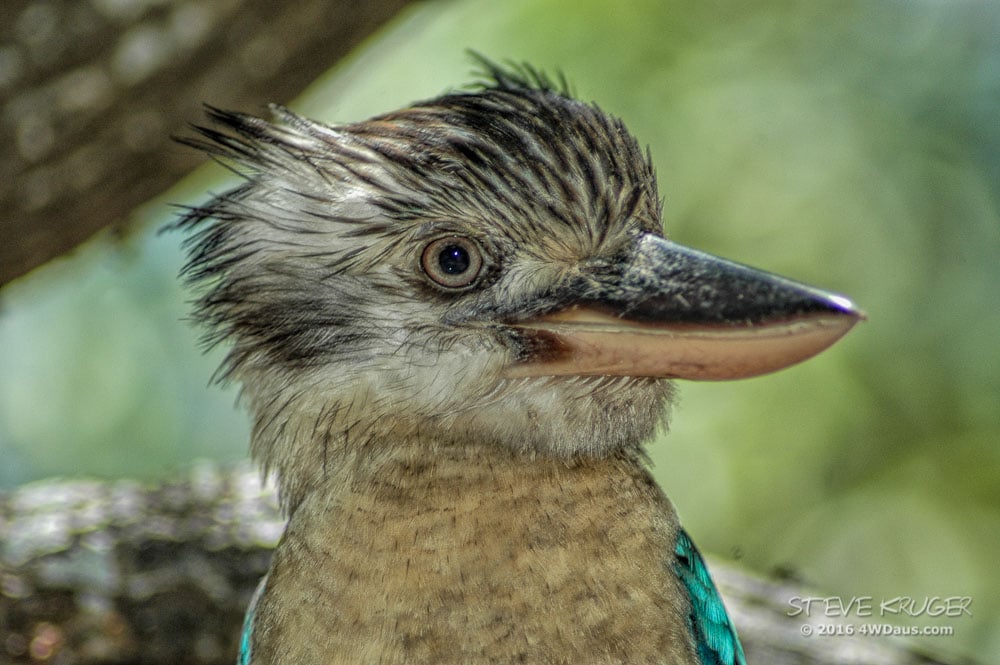
Blue winged kookaburra at Pococks Beach NT
Saturday 9th
A rest day has been declared! So we have sat, looked at the beach, eat and rested. Early next week we will head back to Darwin and address the exhaust and more importantly the axle. We had two Blue Winged Kookaburras for company for most of the day. These guys amazed us on how they extracted the hermit crabs from their shells by holding them in their beaks and thrashing them on a log until they lost their shell.
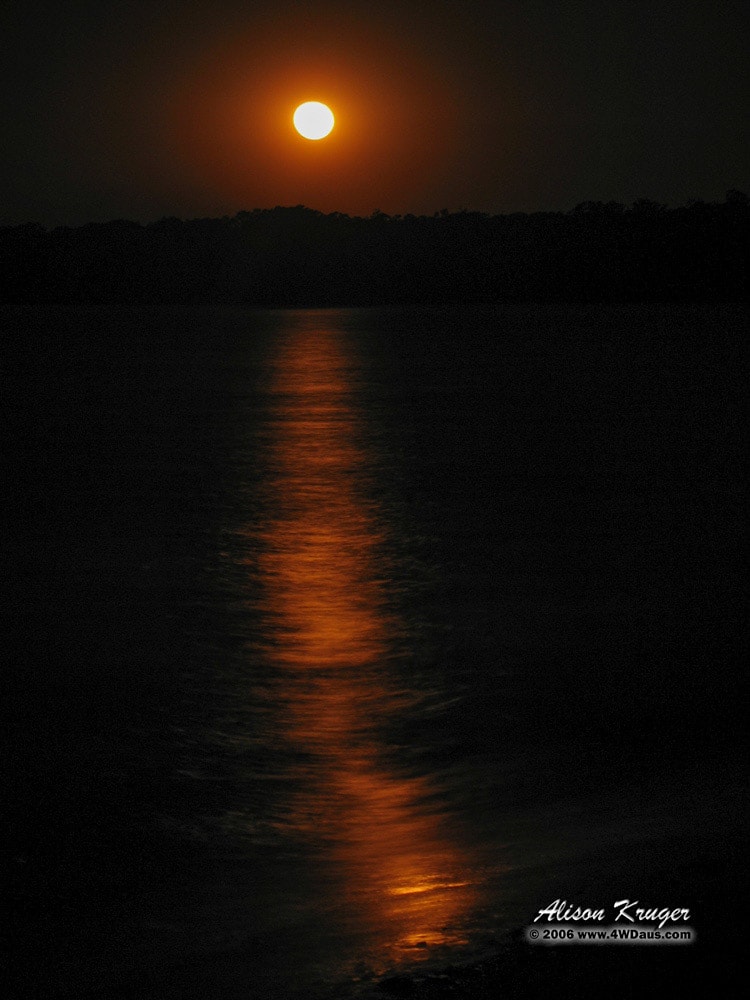
Moonrise Pococks Beach
Later in the evening we built a good size fire and waited for the moon to rise. At 8.08pm a bright orange full moon rose over the inlet and our beach, flooding the darkness with its brightness and glow. This corresponded with the high tide for the day which must have come in 1km across the flats.
Sunday 10th
This morning we both found it really difficult to get out on the road. We were not tired, just really enjoying the beach, the shade and the peace and quiet. About 11am we got a huge surprise when the HEMA Map guys rolled into our camp. OK who are the HEMA Map guys. We first read about these mappers in Australian 4WD Monthly. In the article they were remapping Len Beadell’s tracks across the desserts. The article described all their gear (including multiple GPS’s and their laptop) they use in their travels and even gave us the suggestion of the Stable Table for the laptop.
Back to the story… so when Charles & Keith arrived to say hi and to check our beach out,(as part of their mapping exercises) we were able to see firsthand the people and the equipment we had read about. They told us some of the history of HEMA and how much they enjoy their jobs over a cup of coffee. They certainly travel a lot, totalling 160,000km in 2 years. Their drive into West Alligator Head also claimed one of their tyres, a big Cooper STT type.
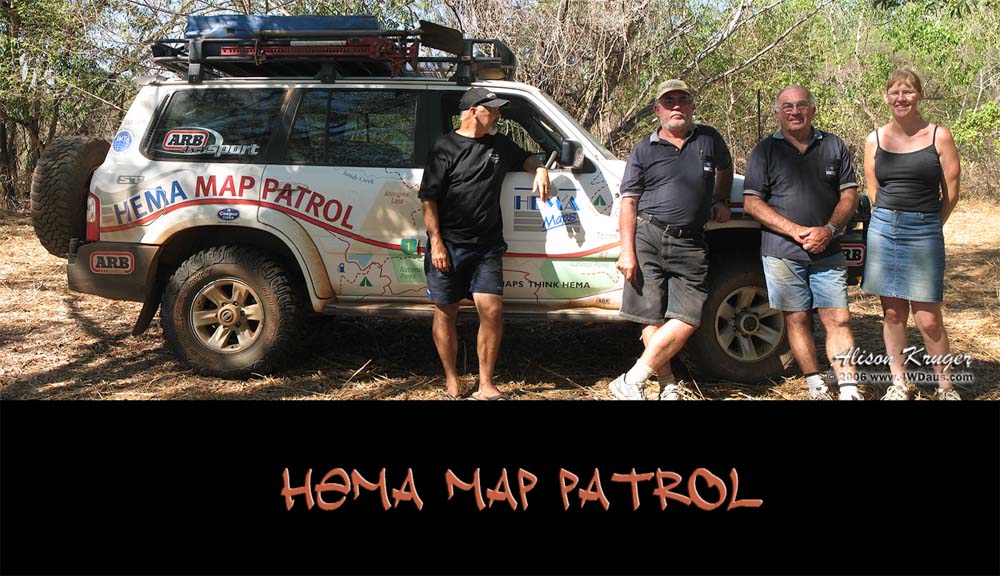
Hema Map Patrol
Sometime after noon we finally bid the beach good bye and headed back onto the track for Jabiru, only to see the ranger and stop again for a chat. It was interesting how he knew the local wild life and in particular a 4.5m salt water croc which lived on the other end of our beach. It did concern him a little the boaties who had decided to pitch their tent quiet close to the crocs creek and we suspect they will be moved on again by the evening when they find out how close their neighbour is!
So by 3pm we made it back the 81km to the main highway were we drove to Mamukala. This is another lagoon famous for it Magpie Geese. Now as you may have remembered Law No 1 which says if a place is named after an animal the animal will not be present when you visit – EG Bird Lagoon, the law should also mention if a place is also famous for something, it will also not be present. Every cloud has a silver lining though. We met 2 photographers, Dale and Peter who both had Nikon Cameras, but these were huge compared to Steve’s. We are told you cannot swap a small 4WD for one of the camera’s; namely the Nikon D2X. Peter specialises in wild life photography and Derek was learning some of the finer points from the master. His specialty is landscapes normally. The 2 of them were wrapped in our real time mapping capabilities and very impressed with Steve’s photography.
Monday 11th
Today we woke in a caravan park in Jabiru ready for a big day of exploring. Our first stop was the Bowali Visitor Centre. The architecture impressed us both as it was the first real Northern Territory ideal design we had encountered. The long covered walkways and wide sweeping decks we think are ideally suited to the heat. Just as impressive was the visitors centre (we don’t usually give praise easily) with its displays and information.
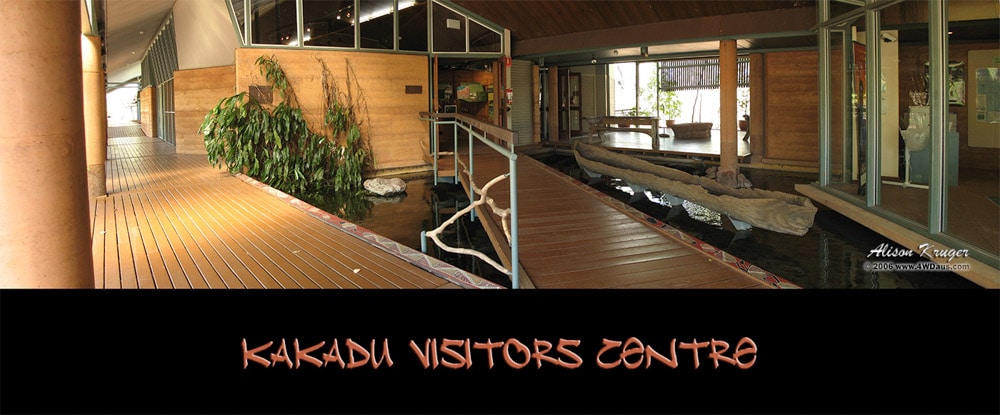
Kakadu Visitors Centre
From the visitor’s centre we moved onto the Ranger Uranium mine to ask for a free sample, just joking, we asked if they still have mine tours. Unfortunately for us, they told us they don’t do tours anymore and they handed us a brochure. So what can we tell you, there is a huge big hole there and an equally big mountain they have created (the dirt from the hole). The machinery is also equally large and constantly on the move in and out of the pit, certainly a big operation.
The next stop for the day was the Ubirr Rock Art display which is north of Jabiru. We have encountered aboriginal paintings in our travels at other locations and had left them feeling disappointed. Today, the Ubirr display was the jewel in the crown for our trip so far and well worth the time, effort and travel to experience it. Some of the artistry is said to be 20,000 years old and the stories they tell of the dreamtime fascinating. You certainly can pick out the different animals and even the type of fish.
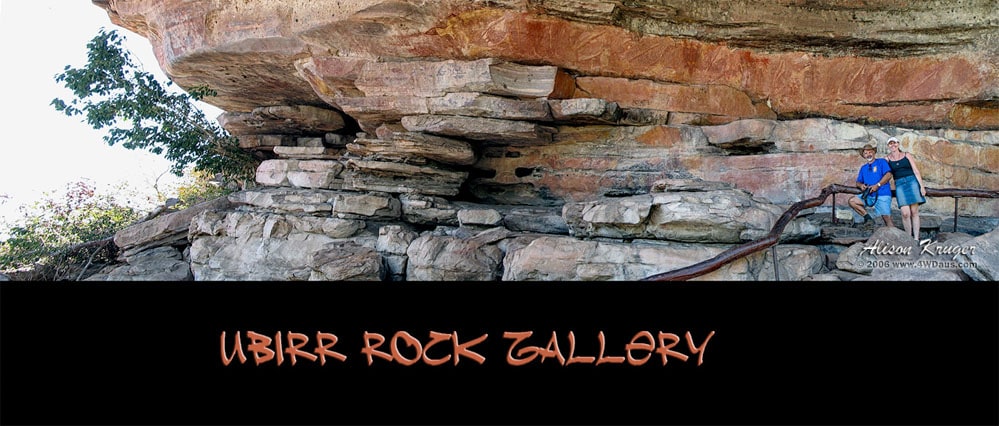
Ubirr Rock Art
Nourlangie Rock was the next stop for the day just south of Jabiru. This site, after a relatively short hike, offered distant views of the surrounding sandstone escarpments and the flood plains Kakadu is so famous for. A picture is the only way you could describe such a breath taking view.
The next point of interest was the Anbangbang Gallery, another Aboriginal Art site. The art here was well worth the time to see and again told stories from the dreamtime. We also ran into a film crew from the BBC, so if you happen to be in England, you might just see us on TV.
With the day getting late we decided to head for Sandy Billabong to camp for the night. The billabong has been swollen by the late rains in Kakadu and the effects of Cyclone Monica. Once again the bird life is abundant and evening filled with their chatting and squawking.
Stay tuned as the adventure continues……






































